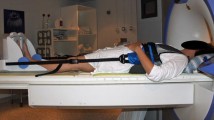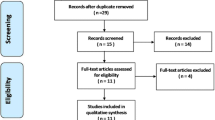Abstract
Purpose
The aims were to investigate if the detection of high-intensity zones (HIZ) is affected by axial load, and to study the correlation between HIZ and discogenic pain provoked with pressure controlled discography (PCD).
Methods
41 consecutive patients with chronic low back pain, referred for discography, were included. Each patient underwent PCD, CT, MRI, and axial loaded MRI (alMRI) within 24 h. 35 patients completed all MRI sequences (140 discs). The detection of HIZ was compared between conventional MRI and alMRI. PCD was performed in 119 of the discs examined at MRI. Provoked pain at PCD was classified into four categories (none/unfamiliar/similar/exact), with the patients’ daily pain as reference, and correlated with presence of HIZ.
Results
AlMRI did not affect the detection of HIZ compared with conventional MRI. No significant correlation between HIZ and the 4-graded pain response at discography was found (p = 0.34), neither when combining similarly/exactly reproduced pain (p = 0.08). The sensitivity, specificity, positive predictive value (PPV) and negative predictive value (NPV) of HIZ in detecting discs with exactly reproduced pain were 49, 69, 39 and 76 %. When combining similarly/exactly reproduced pain, PPV was higher but still only 70 %.
Conclusions
The detection of HIZ was not influenced by axial load. With strict PCD, discogenic pain can neither be confirmed when having HIZ (PPV 39 %) nor ruled out in discs without HIZ (NPV 76 %). Larger PCD studies including quantification of HIZ at conventional and alMRI are needed, before any dynamic component affected by axial load can be ruled out completely.


Similar content being viewed by others
References
Aprill C, Bogduk N (1992) High-intensity zone: a diagnostic sign of painful lumbar disc on magnetic resonance imaging. Br J Radiol 65:361–369
Peng B, Hou S, Wu W, Zhang C, Yang Y (2006) The pathogenesis and clinical significance of a high-intensity zone (HIZ) of lumbar intervertebral disc on MR imaging in the patient with discogenic low back pain. Eur Spine J 15:583–587. doi:10.1007/s00586-005-0892-8
Lim CH, Jee WH, Son BC, Kim DH, Ha KY, Park CK (2005) Discogenic lumbar pain: association with MR imaging and CT discography. Eur J Radiol 54:431–437. doi:10.1016/j.ejrad.2004.05.014
Lei D, Rege A, Koti M, Smith FW, Wardlaw D (2008) Painful disc lesion: can modern biplanar magnetic resonance imaging replace discography? J Spinal Disord Tech 21:430–435. doi:10.1097/BSD.0b013e318153f7e4
Carragee EJ, Paragioudakis SJ, Khurana S (2000) 2000 Volvo Award winner in clinical studies: lumbar high-intensity zone and discography in subjects without low back problems. Spine (Phila Pa 1976) 25:2987–2992
Saifuddin A, Braithwaite I, White J, Taylor BA, Renton P (1998) The value of lumbar spine magnetic resonance imaging in the demonstration of anular tears. Spine (Phila Pa 1976) 23:453–457
Ricketson R, Simmons JW, Hauser BO (1996) The prolapsed intervertebral disc. The high-intensity zone with discography correlation. Spine (Phila Pa 1976) 21:2758–2762
O’Neill C, Kurgansky M, Kaiser J, Lau W (2008) Accuracy of MRI for diagnosis of discogenic pain. Pain Physician 11:311–326
Lam KS, Carlin D, Mulholland RC (2000) Lumbar disc high-intensity zone: the value and significance of provocative discography in the determination of the discogenic pain source. Eur Spine J 9:36–41
Schellhas KP, Pollei SR, Gundry CR, Heithoff KB (1996) Lumbar disc high-intensity zone. Correlation of magnetic resonance imaging and discography. Spine (Phila Pa 1976) 21:79–86
Ito M, Incorvaia KM, Yu SF, Fredrickson BE, Yuan HA, Rosenbaum AE (1998) Predictive signs of discogenic lumbar pain on magnetic resonance imaging with discography correlation. Spine (Phila Pa 1976) 23:1252–1258 (discussion 1259–1260)
Yoshida H, Fujiwara A, Tamai K, Kobayashi N, Saiki K, Saotome K (2002) Diagnosis of symptomatic disc by magnetic resonance imaging: T2-weighted and gadolinium-DTPA-enhanced T1-weighted magnetic resonance imaging. J Spinal Disord Tech 15:193–198
Weishaupt D, Zanetti M, Hodler J, Min K, Fuchs B, Pfirrmann CW, Boos N (2001) Painful lumbar disk derangement: relevance of endplate abnormalities at MR imaging. Radiology 218:420–427
Zuo J, Joseph GB, Li X, Link TM, Hu SS, Berven SH, Kurhanewitz J, Majumdar S (2012) In vivo intervertebral disc characterization using magnetic resonance spectroscopy and T1rho imaging: association with discography and Oswestry Disability Index and Short Form-36 Health Survey. Spine 37(3):214–221
Kang CH, Kim YH, Lee SH, Derby R, Kim JH, Chung KB, Sung DJ (2009) Can magnetic resonance imaging accurately predict concordant pain provocation during provocative disc injection? Skeletal Radiol 38:877–885. doi:10.1007/s00256-009-0709-7
Rankine JJ, Gill KP, Hutchinson CE, Ross ER, Williamson JB (1999) The clinical significance of the high-intensity zone on lumbar spine magnetic resonance imaging. Spine (Phila Pa 1976) 24:1913–1919 (discussion 1920)
O’Neill C, Kurgansky M (2004) Subgroups of positive discs on discography. Spine (Phila Pa 1976) 29:2134–2139. doi:00007632-200410010-00009
Derby R, Kim BJ, Lee SH, Chen Y, Seo KS, Aprill C (2005) Comparison of discographic findings in asymptomatic subject discs and the negative discs of chronic LBP patients: can discography distinguish asymptomatic discs among morphologically abnormal discs? Spine J 5:389–394. doi:10.1016/j.spinee.2005.01.007
Alyas F, Sutcliffe J, Connell D, Saifuddin A (2010) Morphological change and development of high-intensity zones in the lumbar spine from neutral to extension positioning during upright MRI. Clin Radiol 65:176–180. doi:10.1016/j.crad.2009.02.023
Danielson B, Willen J (2001) Axially loaded magnetic resonance image of the lumbar spine in asymptomatic individuals. Spine (Phila Pa 1976) 26:2601–2606
Derby R, Kim BJ, Chen Y, Seo KS, Lee SH (2005) The relation between annular disruption on computed tomography scan and pressure-controlled diskography. Arch Phys Med Rehabil 86:1534–1538. doi:10.1016/j.apmr.2005.02.012
Cicchetti DV, Sparrow SA (1981) Developing criteria for establishing interrater reliability of specific items: applications to assessment of adaptive behavior. Am J Ment Defic 86:127–137
Derby R, Lee SH, Lee JE (2011) Comparison of pressure-controlled provocation discography using automated versus manual syringe pump manometry in patients with chronic low back pain. Pain Med 12:18–26. doi:10.1111/j.1526-4637.2010.00990.x
Lee J, Kim YD, Park CG, Kim MY, Chang IY, Zuo DC, Shahi PK, Choi S, Yeum CH, Jun JY (2012) Neurotensin modulates pacemaker activity in interstitial cells of Cajal from the mouse small intestine. Mol Cells. doi:10.1007/s10059-012-2290-5
Beattie PF, Brooks WM, Rothstein JM, Sibbitt WL Jr, Robergs RA, MacLean T, Hart BL (1994) Effect of lordosis on the position of the nucleus pulposus in supine subjects. A study using magnetic resonance imaging. Spine (Phila Pa 1976) 19:2096–2102
Chen JY, Ding Y, Lv RY, Liu QY, Huang JB, Yang ZH, Liu SL (2011) Correlation between MR imaging and discography with provocative concordant pain in patients with low back pain. Clin J Pain 27:125–130
Seo KS, Derby R, Date ES, Lee SH, Kim BJ, Lee CH (2007) In vitro measurement of pressure differences using manometry at various injection speeds during discography. Spine J 7:68–73. doi:10.1016/j.spinee.2006.05.013
Hebelka H, Gaulitz A, Nilsson A, Holm S, Hansson T (2010) The transfer of disc pressure to adjacent discs in discography: a specificity problem? Spine (Phila Pa 1976) 35:E1025–E1029. doi:10.1097/BRS.0b013e3181dc9e0f
Acknowledgments
The study was supported by funds from University of Gothenburg (ALF) and Gothenburg Medical Society.
Conflict of interest
None.
Ethical standard
Ethical approval was granted by the Ethics Committee of Gothenburg, Sweden.
Author information
Authors and Affiliations
Corresponding author
Rights and permissions
About this article
Cite this article
Hanna, H., Tommy, H. HIZ’s relation to axial load and low back pain: investigated with axial loaded MRI and pressure controlled discography. Eur Spine J 22, 734–739 (2013). https://doi.org/10.1007/s00586-012-2501-y
Received:
Accepted:
Published:
Issue Date:
DOI: https://doi.org/10.1007/s00586-012-2501-y




